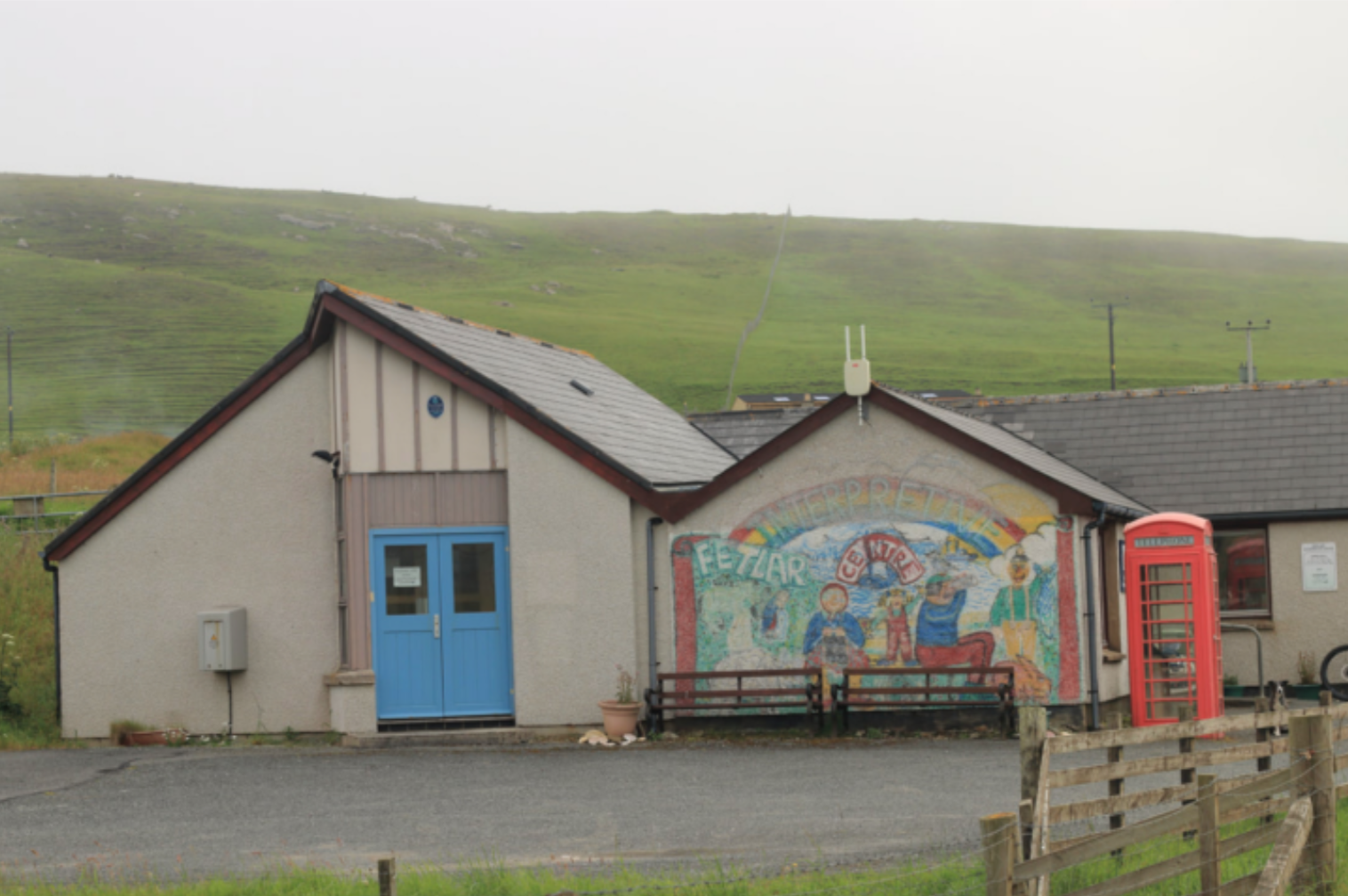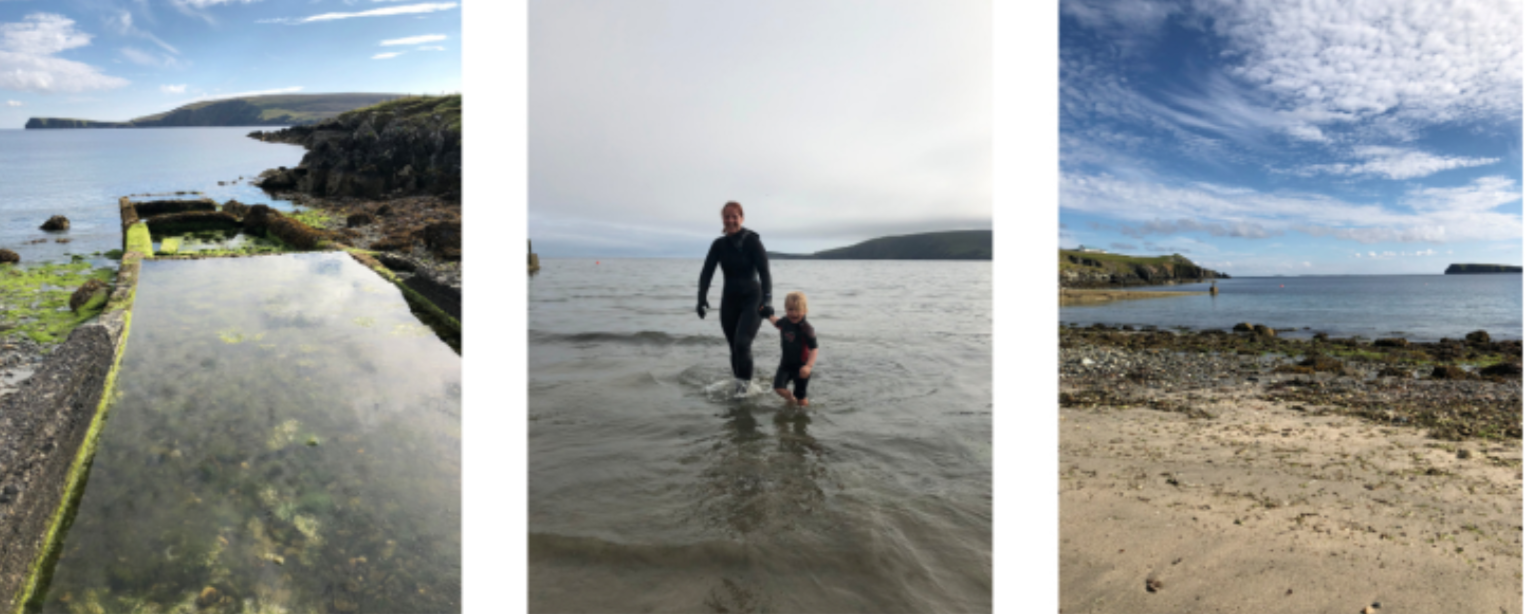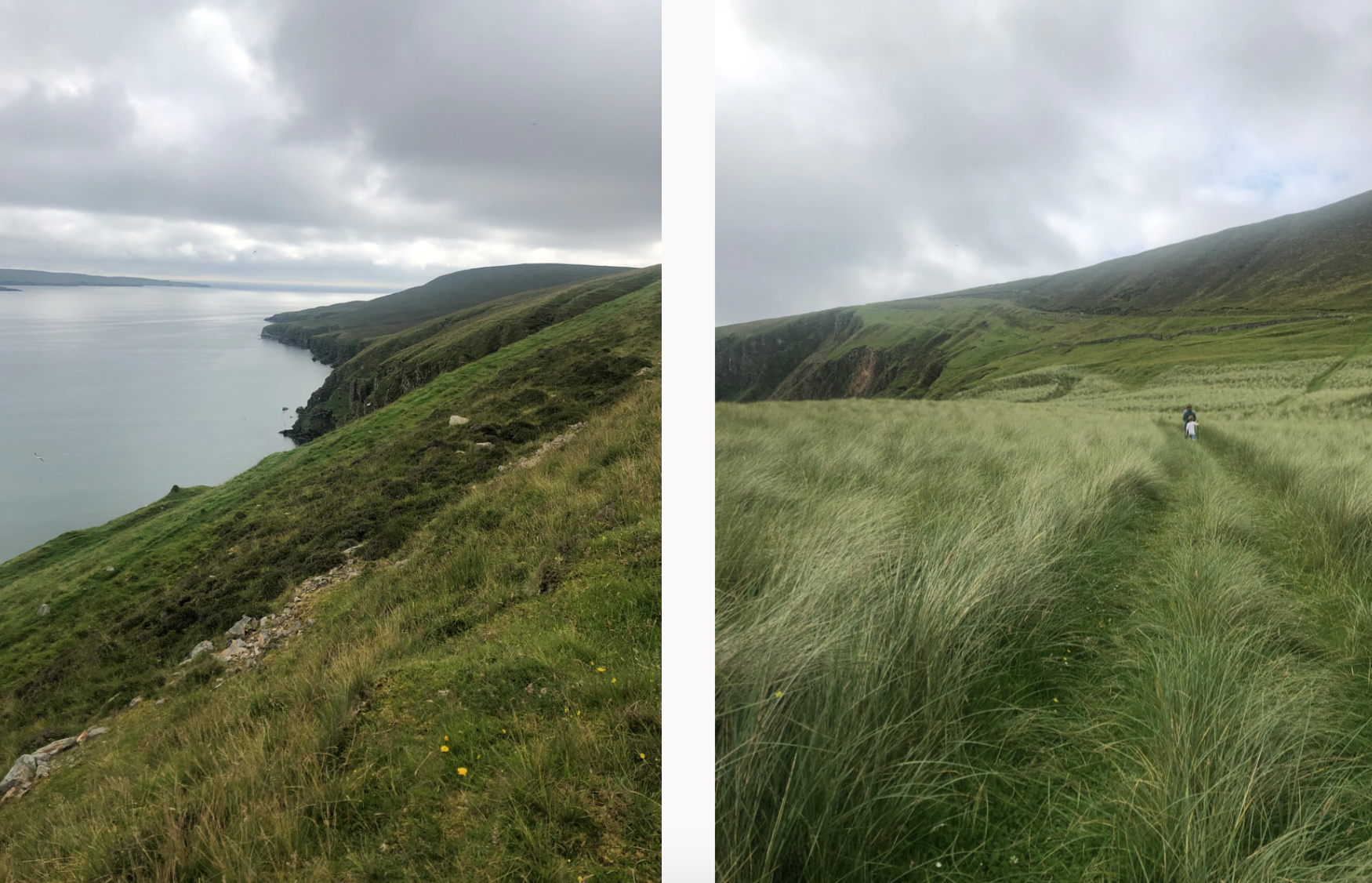The Lodge, Fetlar: A review and itinerary for your stay
The Lodge in Fetlar; the perfect rural retreat in Shetland.
In early August we stayed in an award-winning self-catering cottage in Fetlar. The Lodge sits tucked above the shore, overlooking Lambhoga, and won the 2019 Lux Life’s most Tranquil Accommodation award. And wow, what a spot. As you drive into Houbie, the heart of the island, The Lodge comes into view. Nestled in the shadow of the impressive, if imposing, Leagarth House to which the Lodge was built to serve; originally as a gardener’s cottage for the early-20th-century mansion. The Lodge was built in 1900 for then-owner Sir Watson Cheyne, a pioneering surgeon who grew up in Fetlar.
Fetlar
Fetlar, one of Shetland’s three North Isles has endearingly been known as the ‘Garden of Shetland’ since Norse times, and it’s easy to understand why. The stunning landscapes, fertile valleys and diverse geology give rise to the most incredible display of flora and fauna. As we walked through the island, I was amazed by the array of flowers; scented meadowsweet, wild angelica and hogweed, vibrant bog asphodel, sunny buttercups, carpets of eyebright and creeping willow, and, a personal highlight for the whole family, young and old – heather berries.
Bog cotton
Bog asphodel
Meadowsweet
Today Fetlar has a population of 60, with two new families set to move into the isle before the year is out. We were joined on the 25-minute ferry crossing from Yell by one other car – the ‘shop’ car. The Landrover was stacked to the rafters with boxes marked ‘Fetlar shop’, having made the weekly journey to the mainland, bringing vital supplies to the island. The shop is in Houbie, just up the hill from The Lodge, and is very much the centre of the community here. Well-stocked and friendly, I think we sold them out of both ice-cream and Lerwick Brewery’s ‘Tushker’ beer (and I can only apologise to the residents who were left disappointed after a long day in the sun to discover that their local shop was out-of-stock!).
Loch of Funzie, Fetlar.
Despite being a remote and picturesque getaway, Fetlar has not been without its share of problems over the years. In the 19th century, the landlord (laird) evicted many of the tenant farmers from the land to make way for large-scale sheep farming and the island never really recovered. This was known as the clearances and I wrote more about that here. By the 1990s the population was at an all-time low. So it’s heartening to hear that new life is coming to the island as new families, and life, move in. The clearances undoubtedly left many scars on the community, mostly in the form of ruined houses and homesteads; homes once filled with warmth and happiness, reduced to gloomy ruins with empty hearths.
Views from the front door of The Lodge across the Wick of Tresta and Lambhoga.
Views from the front door of The Lodge across the Wick of Tresta and Lambhoga.
Fetlar has been inhabited for about 5,000 years, and it has been argued that the first Vikings in Shetland arrived in Fetlar, although Unst could well dispute this claim! One thing is clear, as you walk through the island, the hand of ancient man is all around you, and if you tune the eye to the landscape, you can read it like a book. The story of Fetlar is the story of Shetland’s broader past. (I wrote more about the arrival of the Vikings here.)
Getting to Fetlar
Fetlar is relatively easy to get to, although ferry booking is advised. The journey involves two crossings; from Toft (Mainland) to Ulsta (Yell), and then Gutcher (Yell) to Hamars Ness (Fetlar), often with a drop in at Unst to pick up more passengers en route. To get to Toft, follow the A970 from Lerwick then the A968 towards Mossbank. The first crossing takes about 15 minutes. Allow half an hour to travel through Yell towards Gutcher. The final leg, Gutcher to Hamar’s Ness, takes 25 minutes on the ferry.
Fetlar ferry at Hamar's Ness.
The Shetland Islands Council operates Shetland’s network of Inter-Island ferries, and timetables and bookings can be made here.
The Lodge, situated in Houbie, Fetlar.
The Lodge, Houbie
It’s hard to fault the accommodation provided at The Lodge. The setting is so serene and relaxing that it’s little wonder it won an award for tranquillity this year. The Lodge itself is a three bedroom self-catering cottage that is well kitted out and thoughtfully renovated. It oozes serenity and calm, and the pastel-coloured wood-lined walls throughout the house give the place a soothing sense of peace – sure to relieve any stress or anxiety.
Bedroom views from The Lodge, Fetlar.
There are two doors; one at the front of the property with off-road parking, and one at the back that leads onto the main road. But don’t fear, traffic is not an issue here, and the roads are quiet. We used the door at the front of the house, a sunny spot with breathtaking, uninterrupted views out to sea.
The house itself was faultless. From the kitchen that you enter, a door leads into the lounge that, in turn, takes you through the house towards the three generously sized bedrooms and bathroom. The bathroom has both shower and bath – perfect for showering down and bathing sandy children. The bedrooms beyond are fresh and clean, with ample space and storage.
The house is well-equipped with everything that you might need during your stay; well-stocked kitchen, wifi, TV, information, games and books and the glorious views across the Wick of Tresta.
What struck me the most about The Lodge was the incredible light that poured in through the south-facing windows. It was hard not to feel chilled out and inspired here. I imagine it to be an artist’s dream; an ever-changing tapestry as the soft, late-summer light diffuses into the room, creating a relaxing and meditative feel, while outside, the sea glistens tantalisingly.
Houbie, Fetlar, with Leagarth House in the foreground and The Lodge behind.
A weekend in Fetlar (some ideas for your stay)
I have written a lot about Fetlar; last year, I wrote two blogs about things to do in Fetlar that included:
Everland to Gruting circular walk (including the 19th-century folly built by the laird)
Viking boat burial site
Haltadans stone circle
Brough Lodge
Leagarth House
Tresta
(You can read more about these suggestionshere andhere).
Returning this year, we stroked off a few more ‘must do’s’ from the list from an island which has a tremendous amount to give.
Houbie, Fetlar, with views to Leagarth and The Lodge.
Houbie
Houbie itself has a lot to offer within a stone’s throw of The Lodge. Fetlar Interpretive Centre is just across the road, offering a glimpse into the island’s history, culture, tradition, people and folklore. It is well worth spending an afternoon as there is a lot of information to get through. A testament to the quality of this community-run museum is its four-star Visit Scotland rating.
Fetlar Interpretive Centre, Houbie.
The Centre is open from May to September (Monday to Saturday 11 - 4 pm; Sunday 12.30 - 4 pm).
Also in Houbie, just beside The Lodge is a beautiful, sandy beach, complete with a 19th-century stepped pool system, designed to encourage trouts to breed in the stream. The beach has a pier and slipway, and we spent every evening of our stay in wetsuits exploring the shoreline and bay beyond.
The beach at Houbie, beside The Lodge, with the trout pools on the left.
Coastal walk from Houbie to Tresta
Houbie is an excellent location to explore every corner of Fetlar, and we began our stay by walking the coast between Houbie and Tresta before returning to The Lodge via the main road.
Walk distance: 5 miles
We began at the Lodge, following the coastline to Tresta Beach. This part of the walk is 1.5 miles and incorporates stunning scenery, geology, archaeology and cliffs.
Along the way, in Dammins and Clemmel Geo, we discovered a steatite quarry with bowl-shaped carvings and initials engraved in the rock face; documenting years of human history in this area.
Steatite/soapstone workings in Fetlar.
Steatite/soapstone workings in Fetlar.
Steatite, better known as soapstone, is a soft rock that is extremely easy to carve. It has been used here since prehistoric times; Neolithic people using it to temper pottery. The Viking and Norse settlers later arrived, using it for almost every conceivable purpose in the home and beyond. Steatite/soapstone is synonymous with Norse occupation in Shetland, and its use can be traced all through the North Atlantic. It’s a topic that is close to me, and it formed the basis of my masters thesis, exploring the rise of fishing in Shetland. The thesis tracked the growth of our mainstay industry from Norse times, using the artefactual finds – steatite line-sinkers – as evidence. Outcrops of this versatile rock are found in various places throughout Shetland; notably Unst, Fetlar, Fethaland and Catpund.
Steatite/soapstone items in Shetland Museum. (l-r) line-sinker; toy quernstone; loomweights.
Moving on, we rounded another headland and came on more archaeology; more evidence of Fetlar’s past people. Standing proud on the edge of the cliff sits the Broch of Houbie; a 2,000-year-old Iron Age structure, cloaked in mystery and intrigue. These towers of the past, erected in the mid-Iron Age, still cause archaeologists to stop and scratch their heads, wondering at their purpose and use. The broch, like most of the other 120 broch sites in Shetland, now stands in ruin, but the ramparts are still visible. The conical-shaped mound, rising from the landscape is sure to stop you in your tracks and wonder for a while. We had a picnic here, gazing out over the Wick of Tresta, watching the maalies (fulmars) in their elegant flight, soaring high in the thermals on a warm southerly breeze.
Broch of Houbie; Hansi and Lena stand on top of the now collapsed structure. It has commanding views across the Wick of Tresta.
Impressive ramparts at the Broch of Houbie.
The next part of the walk takes you around to Tresta Beach, where the church and Papil Water come into view. Sheer cliffs, geos and caves punctuate the coastline here, and the path between the fence and the cliff-edge can be narrow in places. This is where we happened on the grumpiest crofter (farmer) I think I have ever met. With many profanities and gesticulations, he tried to clear us from his land – concerned, I suspect, that we were going to drive his sheep and lambs over the cliffs. He needn’t have worried. Growing up in Shetland, we are well aware of how to respect the countryside and everything in it. If you are interested in understanding the Scottish Outdoor Access Code, I have dived into it here.
Tresta Beach coming into view with Papil Water behind.
A quick reference to walking the countryside in Shetland: We have the ‘right to roam’ here, meaning that you can freely explore as you wish. The only requirement is that you respect the land, leave gates as you find them, take away your rubbish and keep dogs on a leash if sheep are around. It is worth bearing in mind that some areas can be dangerous; with sheer cliffs, overhangs, bogs and ground-nesting birds; it is worth doing your homework.
Papil Water, Fetlar.
From Tresta beach we walked around Papil Water, skirting past a colony of bonxies (great skuas) who eyed us with as much suspicion as we gave them. Both parties – us and the bonxies – keeping a respectful distance from the other. Incidentally, this is one of the best trout lochs in Shetland. We then re-joined the road and made our way lazily back to The Lodge with little feet beginning to tire and belly’s rumbling.
Bonxies (great skuas) taking off from Papil Water, Fetlar.
Tresta Beach
Tresta Beach, Fetlar.
This beach deserves a special mention. Outstandingly beautiful, picture-perfect and flanked by the steep slopes of Lambhoga, it commands uninterrupted views across the Wick of Tresta and the North Sea beyond.
Not only is it outstandingly beautiful, but it is also one of five beaches in Shetland to have been awarded a prize in the Keep Scotland Beautiful beach awards in 2019. I wrote about all Shetland’s award-winning beaches here.
The bairns had a ball playing in the crystal-clear turquoise water while we adults enjoyed the picnic benches and a cold beer just above the sand.
Whiling away an afternoon on the beach was no hardship as the wildlife provides a never-ending drama performance overhead. I was most heartened to see scootie Allans (Arctic skuas) – a cousin to the larger bonxie – swiftly flying around. They were chasing tirricks (Arctic terns) and bonxies – their agility, a real sight to behold as they danced above the ebb-stanes, keeping their pursuers at bay. I idly watched a family of dunters (eider ducks) gingerly make their way across the sound, avoiding detection and staying close to the shore. The mother keeping her young close as the acrobatic terns and skuas swooped and dived overhead – nature’s fighter jets fighting for supremacy.
Coastal walk from Tresta to Lambhoga peat shed
This was predominantly a hill walk rather than a coastal walk, although it could be done as a coastal (longer) route. The walk took us four hours but could be achieved much quicker – we stopped along the way to pick heather berries, admire the views and picnic.
Walk distance: 4.5 miles
For this walk, park at the Tresta beach and walk along the beach to the other side where you will find a path/old road that makes the steep passage up the side of Lambhoga. From here, there are spectacular views across the Wick of Tresta, back to Papil Water and Tresta Beach and across to Houbie – and The Lodge, our home for a few days.
The track that we followed continues for about two miles up the hill and inland. On the way, we were distracted by the glut of heather berries. Sweet little bursts of tangy delight, a proper taste of Shetland’s summer. (These are now at home soaking in gin for Christmas). We foraged enough to satisfy our needs, leaving enough behind for the birds who depend on this essential late-summer food source.
Searching for heather berries in Fetlar.
As you scale the ridge of Lambhoga, spectacular views across to Yell – Mid Yell and Aywick – emerge. We tracked the passage of a sailing boat heading north through Colgrave Sound and marvelled at the beautiful flush of moorland colour as the bog asphodel transformed boggy depressions into carpets of vibrant, sunshine-coloured flower.
The track that leads through the hill is very boggy and wet in places. Long neglected, the former peat road weaves haphazardly through the bog. After a wet summer, even my Gore-tex hiking boots failed me as brown, peaty water soaked through to my toes, slowly warming in the heat.
The path is very wet in places on the walk to the 'Peaty Hoose'.
The reason for following this track was to see the “Peat Shelter” at the end of the road. Described by Peter Guy in his Walk Shetland series (1991) as a “derelict shelter” where “peat cutters could rest from their labours in the nearby [peat] banks, now disused. During the ‘flitting’ of peat (bringing home) workers of both sexes lived in such ‘peat hooses’ amongst the peat banks”. (I wrote more about the peat-cutting process in Shetland here.)
My family were pretty unimpressed when I announced that I had found our target; a tumbledown shack, with nothing more standing than part of the corrugated roof and a few empty lemonade bottles. Peter Guy had more luck, saying that: “A plank covered bed-space occupied at least half the space at one end of the ‘hoose’. Thirteen such houses still existed here in the 1960s”.
The 'Peaty Hoose' in Fetlar that I dragged the family to. It has seen better days!
Nevertheless, it was a fantastic spot for a picnic, with panoramic views across the east side of Yell and mainland Shetland, with the Noup of Noss standing proud on the southern horizon.
I tried to wade through the heather that Peter Guy says “elephants could graze”, in search of the ruins of a croft, but the bonxies won the day, and we were forced to turn back to the safety of the ‘peaty hoose’.
It felt like a forgotten place, ruled by the bonxies that glided overhead, diving on us now and again, reminding us that this was their territory and we were trespassers.
It was lovely to bring Grandad along too. Even if he did insist on wearing his hankie on his head to protect from the sun!
Our three days in Fetlar came and went too quickly. The Lodge provided us with the perfect base for exploring and a relaxing place to kick off our boots and wetsuits at the end of the day, with sun-kissed faces and weary legs.
Despite having visited two years on-the-trot, there is still so much to see, do and explore. I left feeling, again, like we had merely scratched the surface of this tantalising little island, tucked away off the north-east coast of Shetland. Next summer, when we return, I will certainly be booking back into The Lodge.
If you too would like to stay in The Lodge, bookings can be made here.
With love,





































